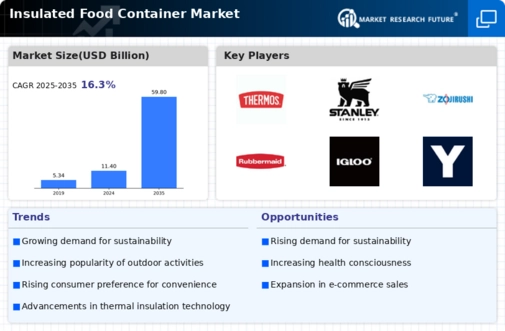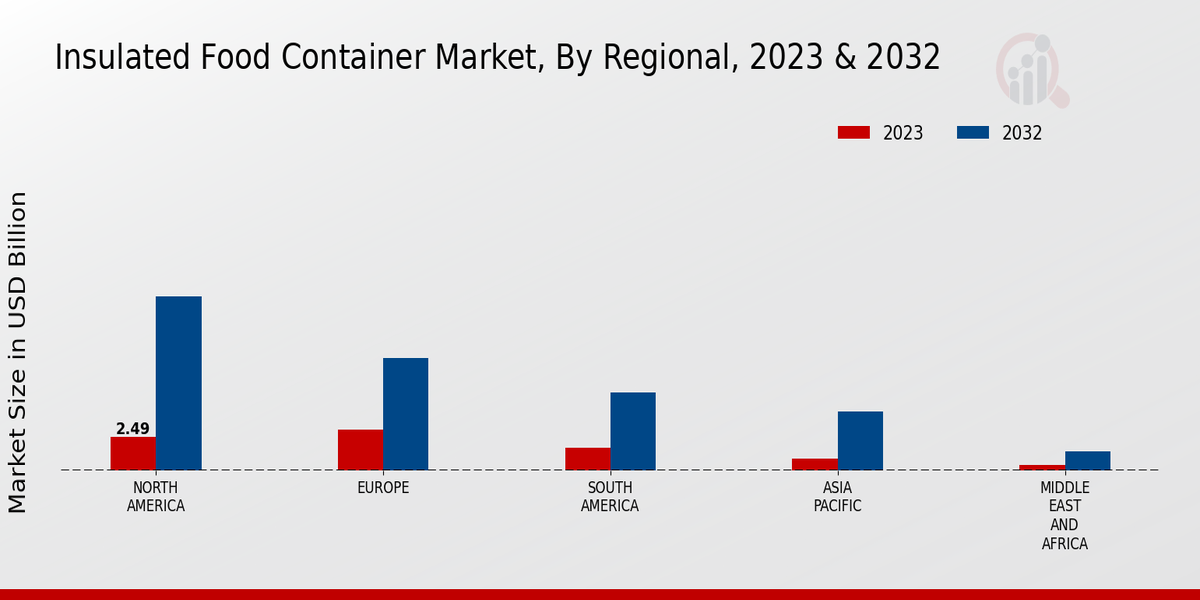Market Growth Projections
The Global Insulated Food Container Market Industry is poised for substantial growth, with projections indicating a market size of 11.4 USD Billion in 2024 and a remarkable increase to 59.8 USD Billion by 2035. This growth trajectory suggests a robust demand for insulated food containers, driven by various factors such as sustainability, health consciousness, and technological advancements. The anticipated CAGR of 16.29% from 2025 to 2035 further underscores the industry's potential for expansion. These figures reflect a dynamic market landscape where innovation and consumer preferences are likely to shape the future of insulated food containers.
Growth in Outdoor Activities
The Global Insulated Food Container Market Industry benefits from the rising popularity of outdoor activities such as camping, hiking, and picnicking. As individuals seek to enjoy meals on the go, insulated food containers provide an effective solution for keeping food fresh and at the desired temperature. This trend is particularly pronounced among millennials and Gen Z, who prioritize convenience and quality in their outdoor experiences. The increasing participation in outdoor events is expected to contribute significantly to market growth, with projections indicating a market size of 59.8 USD Billion by 2035. This demographic shift suggests a robust future for insulated food containers.
Increasing Health Consciousness
The Global Insulated Food Container Market Industry is significantly influenced by the growing health consciousness among consumers. As individuals become more aware of the importance of nutrition and meal preparation, insulated food containers serve as a practical solution for transporting healthy meals. This trend is particularly relevant in urban areas where busy lifestyles make it challenging to maintain healthy eating habits. The ability to prepare and store nutritious meals in insulated containers encourages healthier choices and reduces reliance on fast food. This shift towards health-oriented products is expected to bolster market growth, aligning with the projected increase in market size to 59.8 USD Billion by 2035.
Diverse Applications Across Industries
The Global Insulated Food Container Market Industry is characterized by its diverse applications across various sectors, including food service, healthcare, and education. Insulated containers are utilized not only for personal use but also in commercial settings, where maintaining food temperature is critical. For instance, restaurants and catering services increasingly rely on insulated containers to ensure food safety and quality during transport. This versatility enhances the market's appeal, as businesses recognize the value of insulated solutions in maintaining customer satisfaction. The broad applicability of these products is likely to drive sustained growth, contributing to the anticipated market expansion in the coming years.
Rising Demand for Sustainable Solutions
The Global Insulated Food Container Market Industry experiences a notable shift towards sustainable products as consumers increasingly prioritize eco-friendly options. This trend is driven by heightened awareness of environmental issues and the impact of plastic waste. Manufacturers are responding by developing insulated food containers made from recyclable materials, which appeal to environmentally conscious consumers. The market is projected to reach 11.4 USD Billion in 2024, reflecting a growing preference for sustainable solutions. This shift not only aligns with consumer values but also positions companies favorably in a competitive landscape where sustainability is becoming a key differentiator.
Technological Advancements in Insulation
The Global Insulated Food Container Market Industry is witnessing rapid advancements in insulation technology, enhancing the performance and efficiency of these products. Innovations such as vacuum insulation and advanced materials improve thermal retention, allowing food to remain hot or cold for extended periods. These technological improvements not only elevate consumer satisfaction but also expand the potential applications of insulated food containers across various sectors, including food service and catering. As the market evolves, these advancements are likely to drive growth, contributing to a projected CAGR of 16.29% from 2025 to 2035, indicating a strong trajectory for the industry.




























Leave a Comment